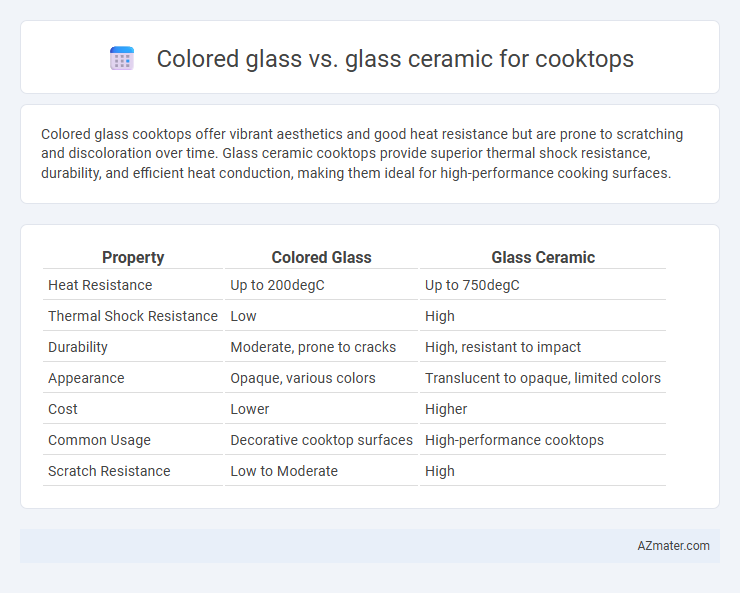Colored glass cooktops offer vibrant aesthetics and good heat resistance but are prone to scratching and discoloration over time. Glass ceramic cooktops provide superior thermal shock resistance, durability, and efficient heat conduction, making them ideal for high-performance cooking surfaces.
Table of Comparison
| Property | Colored Glass | Glass Ceramic |
|---|---|---|
| Heat Resistance | Up to 200degC | Up to 750degC |
| Thermal Shock Resistance | Low | High |
| Durability | Moderate, prone to cracks | High, resistant to impact |
| Appearance | Opaque, various colors | Translucent to opaque, limited colors |
| Cost | Lower | Higher |
| Common Usage | Decorative cooktop surfaces | High-performance cooktops |
| Scratch Resistance | Low to Moderate | High |
Introduction to Cooktop Surface Materials
Cooktop surface materials vary primarily between colored glass and glass ceramic, each offering distinct thermal properties and durability. Colored glass provides a stylish, customizable appearance with moderate heat resistance, while glass ceramic stands out for its superior heat tolerance and rapid temperature changes, ideal for efficient cooking. Understanding these differences assists in selecting a cooktop surface that balances aesthetics with performance and safety.
What is Colored Glass Cooktop?
Colored glass cooktops feature a smooth, durable surface made from toughened glass infused with vibrant pigments, offering both aesthetic appeal and heat resistance. This type of cooktop provides excellent thermal stability and is easy to clean, making it a popular choice for modern kitchen designs. Unlike glass ceramic cooktops, colored glass surfaces prioritize design variety while maintaining functional performance under typical cooking temperatures.
Understanding Glass Ceramic Cooktop
Glass ceramic cooktops offer superior heat resistance and rapid temperature changes, making them ideal for precise cooking control compared to standard colored glass. Engineered from crystalline and glass materials, glass ceramics maintain a smooth, durable surface that resists thermal shock and scratches, enhancing longevity. Unlike colored glass, which mainly provides aesthetics, glass ceramic cooktops integrate functionality with safety features, optimizing energy efficiency and consistent heat distribution.
Appearance and Aesthetics Comparison
Colored glass cooktops offer vibrant hues and customizable finishes, enhancing kitchen aesthetics with a sleek, glossy surface that reflects light for a modern look. Glass ceramic cooktops feature a smooth, matte or semi-gloss finish, providing a sophisticated, subtle appearance that seamlessly integrates with various kitchen designs. The choice between colored glass and glass ceramic ultimately depends on whether bold color or understated elegance best suits the overall kitchen style.
Heat Conductivity and Performance
Colored glass cooktops typically exhibit lower heat conductivity compared to glass ceramic surfaces, resulting in slower and less efficient heat transfer. Glass ceramic cooktops feature high-temperature resistance and superior thermal shock tolerance, enabling rapid heat distribution and consistent cooking performance. Enhanced heat conductivity in glass ceramic materials reduces energy consumption and ensures precise temperature control, making them ideal for high-performance cooking applications.
Durability and Scratch Resistance
Colored glass cooktops offer moderate durability but are more prone to scratches and surface damage over time compared to glass ceramic options. Glass ceramic cooktops exhibit superior scratch resistance due to their crystallized structure, providing enhanced longevity and maintaining a sleek appearance under heavy use. Investing in glass ceramic surfaces ensures better performance and resilience against daily wear and tear in kitchen environments.
Cleaning and Maintenance
Colored glass cooktops offer a smooth, non-porous surface that resists stains and allows for effortless cleaning with mild detergents and non-abrasive cloths. Glass ceramic cooktops require careful maintenance to avoid scratches and discoloration; using specialized cleaners ensures longevity and preserves their heat-resistant properties. Frequent gentle cleaning prevents buildup on both surfaces, but colored glass generally demands less meticulous care compared to glass ceramic.
Cost Differences
Colored glass cooktops typically cost less upfront, ranging from $300 to $900, making them a budget-friendly option for homeowners. Glass ceramic cooktops, known for their durability and heat resistance, generally range from $800 to $2,000, reflecting higher manufacturing and material costs. Maintenance and replacement expenses also tend to be higher for glass ceramic due to specialized repair requirements and material costs.
Suitability for Different Cooking Styles
Colored glass cooktops offer even heat distribution and are ideal for gentle cooking styles such as simmering and slow cooking, providing a visually appealing surface that resists stains. Glass ceramic cooktops excel in high-temperature cooking and rapid heating, making them suitable for searing, boiling, and frying due to their superior thermal shock resistance and durability. Both materials support induction and radiant heat technologies, but glass ceramic's quicker heat response caters better to versatile cooking techniques requiring precise temperature control.
Which Cooktop Material is Best for Your Kitchen?
Colored glass cooktops offer vibrant aesthetics and smooth surfaces that resist stains and are easy to clean, while glass ceramic cooktops provide superior heat resistance and even heat distribution essential for precise cooking. Glass ceramic excels in durability under high temperatures and rapid heat changes, making it ideal for frequent and intensive kitchen use. Choosing the best cooktop material depends on balancing visual appeal with performance demands, where glass ceramic suits high-efficiency cooking and colored glass fits kitchens prioritizing style and ease of maintenance.

Infographic: Colored glass vs Glass ceramic for Cooktop
 azmater.com
azmater.com